Citroen C5 2007.5 (DC/DE) / 1.G Owner's Guide
Manufacturer: CITROEN, Model Year: 2007.5, Model line: C5, Model: Citroen C5 2007.5 (DC/DE) / 1.GPages: 231, PDF Size: 7.63 MB
Page 21 of 231
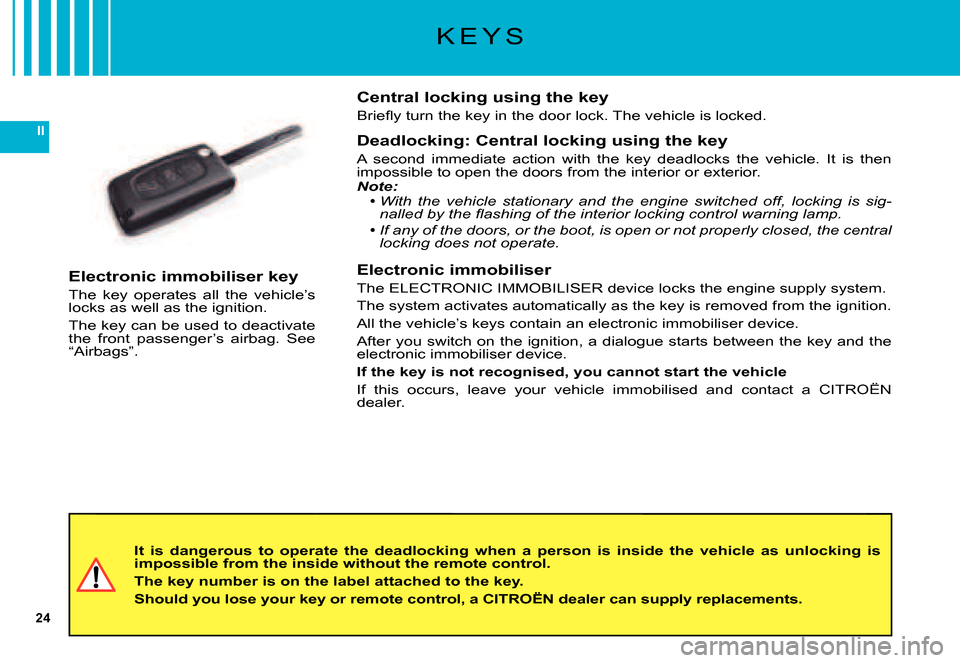
24
II
K E Y S
It is dangerous to operate the deadlocking when a person is inside the vehicle as unlocking is impossible from the inside without the remote control.
The key number is on the label attached to the key.
Should you lose your key or remote control, a CITROËN dealer can supply replacements.
Central locking using the key
�B�r�i�e�fl� �y� �t�u�r�n� �t�h�e� �k�e�y� �i�n� �t�h�e� �d�o�o�r� �l�o�c�k�.� �T�h�e� �v�e�h�i�c�l�e� �i�s� �l�o�c�k�e�d�.
Deadlocking: Central locking using the key
A second immediate action with the key deadlocks the vehicle. I t is then impossible to open the doors from the interior or exterior.Note:With the vehicle stationary and the engine switched off, locking is sig-�n�a�l�l�e�d� �b�y� �t�h�e� �fl� �a�s�h�i�n�g� �o�f� �t�h�e� �i�n�t�e�r�i�o�r� �l�o�c�k�i�n�g� �c�o�n�t�r�o�l� �w�a�r�n�i�n�g� �l�a�m�p�.
If any of the doors, or the boot, is open or not properly clo sed, the central locking does not operate.
Electronic immobiliser
The ELECTRONIC IMMOBILISER device locks the engine supply system.
The system activates automatically as the key is removed from the igni tion.
All the vehicle’s keys contain an electronic immobiliser device.
After you switch on the ignition, a dialogue starts between the key and the electronic immobiliser device.
If the key is not recognised, you cannot start the vehicle
If this occurs, leave your vehicle immobilised and contact a CITRO ËN dealer.
Page 22 of 231

25
II
C O D E C A R D
In the event of a change of vehicle ownership, it is essential for the new owner to possess the CODE card.
Never leave it in the vehicle.
Never attempt to modify the electronic immobiliser’s electrical circuit, as that could render your vehicle undriveable .
Should the confidential card be lost, contact a CIT ROËN dealer.
�A� �c�o�n�fi� �d�e�n�t�i�a�l� �c�a�r�d� �i�s� �g�i�v�e�n� �t�o� �t�h�e� new owner when he takes delivery of his new vehicle.
This card bears a hidden access code for the use of the CITROËN dealer when servicing the elec-tronic immobiliser device.
Do not scratch the protective strip, the security of the immobi-liser system depends on the infor-mation below remaining covered.
Should the card be lost, your immobiliser system can no longer be considered secure.
Advice
Keep the code card bearing your personal electronic immobiliser numb er in a safe place (never in the vehicle).
�I�f� �a�n�y� �k�e�y� �m�o�d�i�fi� �c�a�t�i�o�n�s� �b�e�c�o�m�e� �n�e�c�e�s�s�a�r�y� �(�a�d�d�i�t�i�o�n�,� �c�a�n�c�e�l�l�a�t�i�o�n� �o�r� �r�e�p�l�a�c�e�-ment of the key), It is essential to take the �c�o�n�fi� �d�e�n�t�i�a�l� �c�a�r�d� �t�o�g�e�t�h�e�r� �w�i�t�h� all the keys to a CITROËN dealer.the key), It is
Page 23 of 231
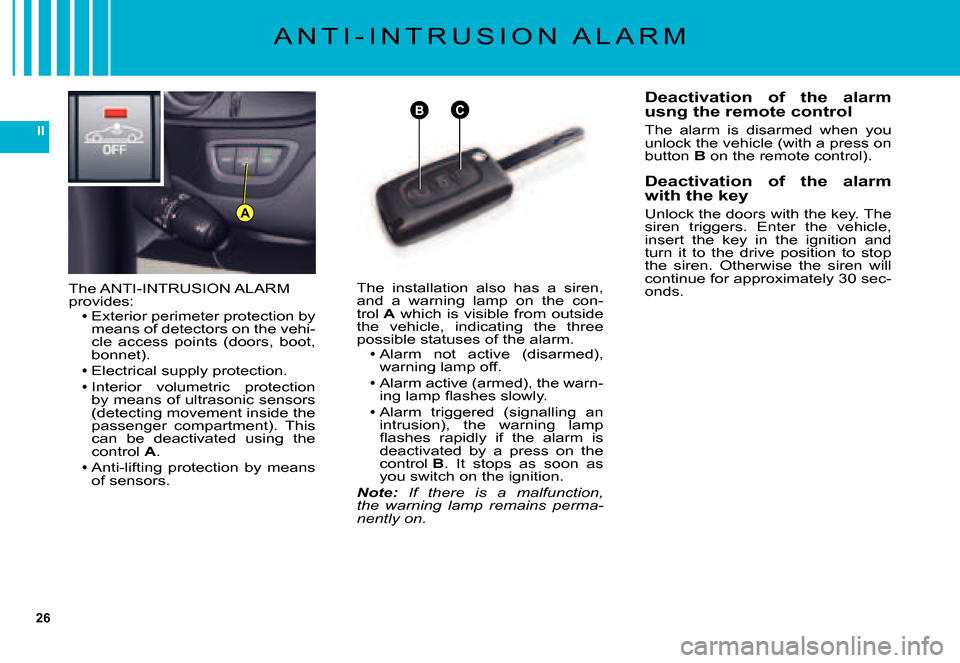
26
II
BC
A
A N T I - I N T R U S I O N A L A R M
The ANTI-INTRUSION ALARM provides:Exterior perimeter protection by means of detectors on the vehi-cle access points (doors, boot, bonnet).
Electrical supply protection.
Interior volumetric protection by means of ultrasonic sensors (detecting movement inside the passenger compartment). This can be deactivated using the control A.
Anti-lifting protection by means of sensors.
Page 24 of 231

27
II
A N T I - I N T R U S I O N A L A R M
Operating the alarm
First make sure all the doors are closed.
The alarm is armed by pressing button C on the remote control.
With the alarm armed, the protections are active after 5 seconds (perimeter) and 45 seconds (volumetric).
When the alarm is armed (on standby), any intrusion will trigger the siren for 30 seconds, accompanied by the direction indicators lighting up.
The alarm then goes back on standby. The triggering remains memorised. The warning lamp on button A�fl� �a�s�h�e�s� �q�u�i�c�k�l�y� �w�h�e�n� �t�h�e� �a�l�a�r�m� �i�s� �d�e�a�c�t�i�v�a�t�e�d� �b�y� �p�r�e�s�s�-ing the unlocking button B�.� �T�h�i�s� �fl� �a�s�h�i�n�g� �s�t�o�p�s� �w�h�e�n� you switch on the ignition.
The siren is also triggered if there is a cutting of the electrical supply. To stop it, restore the electrical supply then press on the unlocking button B.Note:If you want to lock your vehicle without arming the alarm, just lock with the key only.
If you lock your vehicle and a door, or the boot, is still open, the central locking does not operate but the alarm will arm itself after approx. 45 seconds.Note: The siren is automatically deactivated (for exam-ple for disconnecting the battery) as soon as the vehicle is unlocked using the remote control.
Page 25 of 231

28
II
S T E E R I N G L O C K - I G N I T I O N - S T A R T E R
NEVER REMOVE THE IGNITION KEY BEFORE THE ENGINE HAS COME TO A COMPLETE STOP.
IT IS ESSENTIAL ALWAYS TO DRIVE WITH THE ENGINE RUNNING, SO AS TO RETAIN STEERING AND BRAKING ASSISTANCE (risk of the steering lock engaging and loss of safety features).
When stationary, having removed the key, carefully turn the steering wheel if you wish to lock the steering.
S : Steering lock
To unlock the steering, gently move the steering wheel while turning the key, without exerting undue force.
When you remove the key, turn your steering wheel to lock the steering. The key can only be removed when in position S.
M : Drive position
The steering is unlocked (by turn-ing the key in position M, if neces-sary move the steering wheel).
D : Starting
Release the key as soon as the engine starts. Never turn it while the engine is running.
Economy mode
When the engine is stopped, some functions (radio, screen wipe , electric windows, sunroof, electric seats, telephone, video etc) are only electrically supplied for about 30 minutes, to avoid discharging the battery.
Once the 30 minutes are over, a message appears on the instrumen t panel screen and the active functions are put on standby.
The electrical components relating to comfort and also the headlamps (not sidelamps or hazard warning lamps) cut out automatically. To react ivate them, it is necessary to start the engine.
Page 26 of 231

29
II
DO NOT RUN THE ENGINE IN A CLOSED SPACE OR IN ONE THAT IS INSUFFICIENTLY VENTILATED.
Manual gearboxEnsure that the gear lever is in the neutral position.
Do not touch the accelerator.For Diesel engines: Turn the key to the drive position. Wait for the preheater warning lamp to go off, if this has come on.
Turn the key to action the starter (not for more than ten seconds), until the engine starts.Note: In ambient temperatures lower than 0°C, depress the clutch while actioning the starter to facili-tate starting. Then release the clutch pedal slowly.
Page 27 of 231
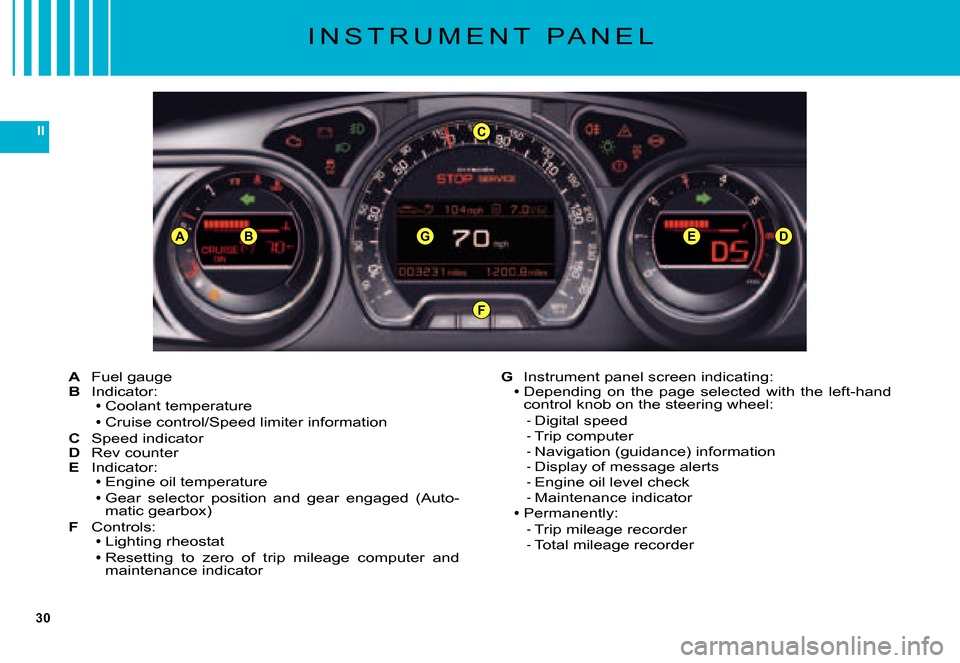
30
II
G
C
F
ADBE
I N S T R U M E N T P A N E L
A Fuel gaugeB Indicator:Coolant temperature
Cruise control/Speed limiter informationC Speed indicatorD Rev counterE Indicator:Engine oil temperature
Gear selector position and gear engaged (Auto-matic gearbox)
F Controls:Lighting rheostat
Resetting to zero of trip mileage computer and maintenance indicator
Page 28 of 231
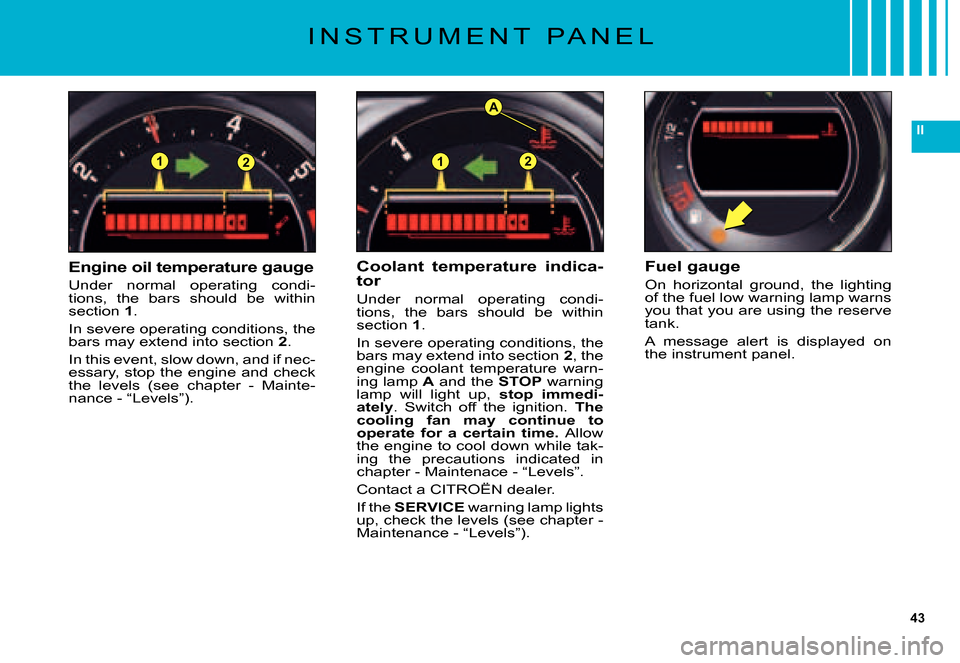
43
II
A
2121
I N S T R U M E N T P A N E L
Engine oil temperature gauge
Under normal operating condi-tions, the bars should be within section 1.
In severe operating conditions, the bars may extend into section 2.
In this event, slow down, and if nec-essary, stop the engine and check the levels (see chapter - Mainte-nance - “Levels”).
Fuel gauge
On horizontal ground, the lighting of the fuel low warning lamp warns you that you are using the reserve tank.
A message alert is displayed on the instrument panel.
Coolant temperature indica-tor
Under normal operating condi-tions, the bars should be within section 1.
In severe operating conditions, the bars may extend into section 2, the engine coolant temperature warn-ing lamp A and the STOP warning lamp will light up, stop immedi-ately.Switch off the ignition. The cooling fan may continue to operate for a certain time. Allow the engine to cool down while tak-ing the precautions indicated in chapter - Maintenace - “Levels”.
Contact a CITROËN dealer.
If the SERVICE warning lamp lights up, check the levels (see chapter - Maintenance - “Levels”).
Page 29 of 231

31
II
I N S T R U M E N T P A N E L
W A R N I N G L A M P S
Left hand direction indicator
See “Signalling”.
Right hand direction indicator
See “Signalling”.
Sidelamps
See “Signalling”.
Front foglamps
See “Signalling”.
Dipped beams
See “Signalling”.
Foglamps (rear)
See “Signalling”.
Main beams
See “Signalling”.
�A�l�l� �t�h�e� �d�i�r�e�c�t�i�o�n� �i�n�d�i�c�a�t�o�r�s� �fl� �a�s�h� �s�i�m�u�l�t�a�n�e�o�u�s�l�y� �w�h�e�n� �t�h�e� �h�a�z�a�r�d� warning lamps are switched on.
Indicator and headlamp warning lamps
Fuel low
In some driving condi-tions and depending on the engine, the range may be less than 50 kilometres (approx. 30 miles).
See “Fuel”.
Diesel engine pre-heater
See method for starting the engine.
See “Starting”.
Electronic parking brake - deactivation of automatic func-tions
This warning lamp comes on if the “automatic locking” (upon switch-ing off the ignition) and the “auto-matic unlocking” functions are deactivated or faulty.
Page 30 of 231
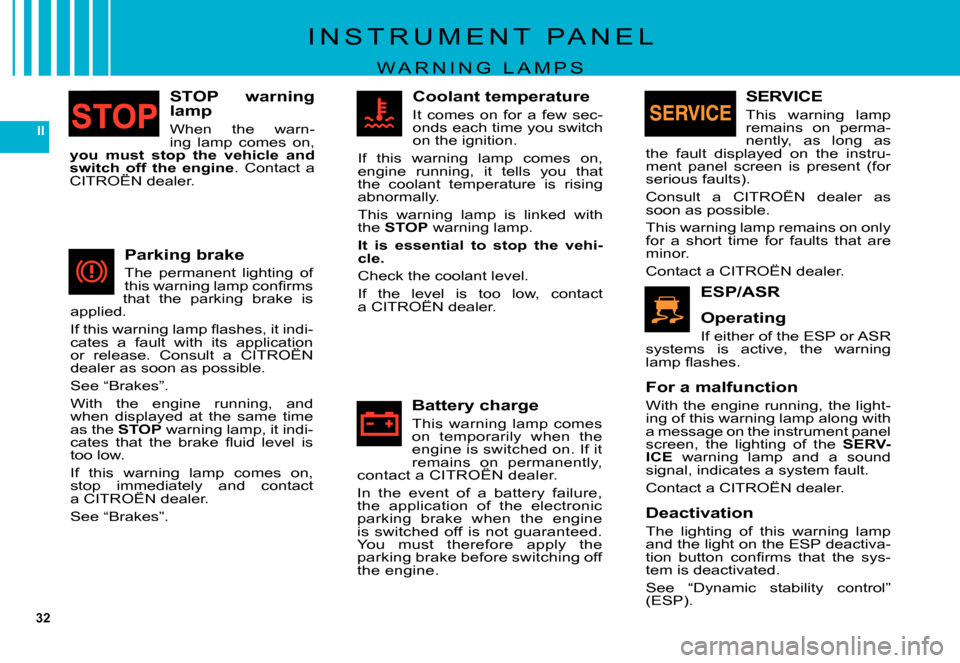
32
II
STOP warning lamp
When the warn-ing lamp comes on, you must stop the vehicle and switch off the engine. Contact a CITROËN dealer.switch off the engineswitch off
Parking brake
The permanent lighting of �t�h�i�s� �w�a�r�n�i�n�g� �l�a�m�p� �c�o�n�fi� �r�m�s� that the parking brake is applied.
�I�f� �t�h�i�s� �w�a�r�n�i�n�g� �l�a�m�p� �fl� �a�s�h�e�s�,� �i�t� �i�n�d�i�-cates a fault with its application or release. Consult a CITROËN cates a fault with its application application
dealer as soon as possible.
See “Brakes”.
With the engine running, and when displayed at the same time as the STOP warning lamp, it indi-�c�a�t�e�s� �t�h�a�t� �t�h�e� �b�r�a�k�e� �fl� �u�i�d� �l�e�v�e�l� �i�s� too low.
If this warning lamp comes on, stop immediately and contact a CITROËN dealer.stop immediately and immediately
See “Brakes”.
Battery charge
This warning lamp comes on temporarily when the engine is switched on. If it remains on permanently, contact a CITROËN dealer.remains on permanens on
In the event of a battery failure, the application of the electronic parking brake when the engine is switched off is not guaranteed. You must therefore apply the parking brake before switching off the engine.
I N S T R U M E N T P A N E L
W A R N I N G L A M P S
SERVICE
This warning lamp remains on perma-nently, as long as the fault displayed on the instru-ment panel screen is present (for serious faults).
Consult a CITROËN dealer as soon as possible.
This warning lamp remains on only for a short time for faults that are minor.
Contact a CITROËN dealer.
ESP/ASR
Operating
If either of the ESP or ASR systems is active, the warning �l�a�m�p� �fl� �a�s�h�e�s�.
For a malfunction
With the engine running, the light-ing of this warning lamp along with a message on the instrument panel screen, the lighting of the SERV-ICE warning lamp and a sound signal, indicates a system fault.
Contact a CITROËN dealer.
Deactivation
The lighting of this warning lamp and the light on the ESP deactiva-�t�i�o�n� �b�u�t�t�o�n� �c�o�n�fi� �r�m�s� �t�h�a�t� �t�h�e� �s�y�s�-tem is deactivated.
See “Dynamic stability control” (ESP).
Coolant temperature
It comes on for a few sec-onds each time you switch on the ignition.
If this warning lamp comes on, engine running, it tells you that the coolant temperature is rising abnormally.
This warning lamp is linked with the STOP warning lamp.
It is essential to stop the vehi-cle.
Check the coolant level.
If the level is too low, contact a CITROËN dealer.If the level is too